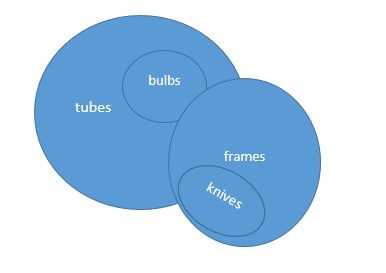Question
Statements- 1.All bulbs are tubes. 2.Some
tubes are knives. 3.All knives are frames. 4.Some frames are bulbs. Conclusions. 1. Atleast some bulbs are frames. 2. Some tubes are not knives. 3. All frames being tubes is a possibility. In each question below there are four statement followed by three conclusion numbered 1, 2 and 3. You have to take the four given statements to be true even if they seem to be at variance with commonly known facts and then decide which of the given conclusions does not follows from the four given statements, disregarding commonly known facts.Solution
Some frames are bulbs(I) ⇒ Conversion ⇒ Some bulbs are frames(I). Hence conclusion I follows. Some tubes are knives(I) ⇒ Conversion ⇒ Some knives are tubes(I). Hence conclusion II does not follow. Some tubes are knives(I) + All knives are frames(A) ⇒ Some tubes are frames(I) ⇒ Conversion ⇒ Some frames are tubes (I) ⇒ Probable conclusion ⇒ All frames being tubes is a possibility(A). Hence conclusion III follows. Alternate Method: 
Which district is home to the Omkareshwar Floating Solar Project?
Jeevan Dhara, a special savings bank account for pensioners, and prospective pensioners has been launched by which bank in which the Interest rate on sa...
What is the focus of the 'Jal Sanchay Jan Bhagidari' initiative launched by Prime Minister Narendra Modi?
The Insurance Regulatory and Development Authority of India (IRDAI) plans to create which initiative to address protection gaps in states?
Which organization is jointly organizing the India-EU Connectivity Conference in Meghalaya?
How much did Equities contribute to the total National Pension System ( NPS ) Assets Under Management ( AUM ) ?
Who holds the record for the fastest World Cup hundred by an Indian?
What was the unemployment rate (UR) for females aged 15 and above in India for 2023-24 as per the Labour Force Survey?
What agreement did India and Bangladesh reach during recent land port discussions?
What is the investment target under India’s National Green Hydrogen Mission by 2030?
Relevant for Exams:



